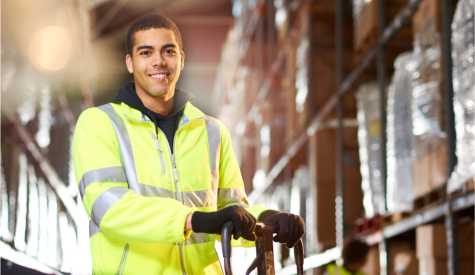Slips, Trips, and Falls Safety Training in the Construction Industry

Nearly one-third of reportable injuries and 40% of fatalities in construction result from slips, trips, and falls. These injuries result in 50% more days away from work than other injuries. Slips, trips, and falls can be caused by slick spots, debris, clutter, and unsafe stairs or ladders. The Occupational Health and Safety Administration, or OSHA, requires employers to protect against these hazards. These tips will help you prevent slips, trips and falls.
Housekeeping
Housekeeping is an effective way to minimize accidents. OSHA requires that passageways be:
- Clear of obstructions
- In good repair
- Large enough to allow safe clearance
Make housekeeping a routine by:
- Picking up after yourself
- Keeping surfaces and stairways clear of debris
- Putting away tools and equipment after use
Your employer should allow time for you to clean your work area.
Indoor and Outdoor Surfaces
Keep outdoor surfaces clean and dry. Treat them with sand, salt, or anti-skid adhesive if necessary. Indoors, use non-slip floor mats and allow people to clean their shoes often.
Floor mats should:
- Have beveled edges
- Lay flat
- Be made out of material that won’t slide
- Be placed where moisture can collect
Finally, wear boots or shoes with good traction.
Lifting Equipment
Construction equipment can create slip, trip, and fall hazards. All lifting equipment requires training to operate. Personal fall arrest systems also require training. Never operate equipment without training. Only use equipment that is in good condition and inspect it before use. If you notice problems, remove it from service and notify a supervisor.
Floor Loading Protection
The load rating is the maximum weight that a surface can safely hold. The approved load limit should be posted. This limit includes the total weight of all people and objects on that surface. It’s unsafe and against the law to exceed the load rating. If you bring an unusual amount of weight onto a surface, or if work is being performed on a surface that hasn’t been rated, check that the surface can handle the load.
Holes and Openings
OSHA defines a hole as a gap or space more than 2 inches wide in any horizontal working surface, and an opening as a gap or space at least 30 inches high and at least 18 inches wide in a vertical surface through which a person could fall.
Holes, and any openings that could lead to a fall, must have:
- Covers or railings to prevent tripping or falling
- A toeboard if tools may fall into it or people can pass under it
If holes or openings must be left temporarily unguarded, they must be attended until covered again.
Stairs and Ladders
To help prevent falls on stairs:
- Always use the handrail
- Turn on lights in the stairwell
- Don’t carry loads that block your view
- Check individual stairs regularly for damage
- Repair steps when necessary
- Keep stairways clear
- Clean up any moisture you find
In general, to help prevent falls from ladders:
- Inspect it prior to use to make sure it has no defects
- If damaged, remove ladder from service, tag it “Dangerous, Do Not Use,” and notify your supervisor
- Never use metal ladders around electrical equipment
- Never exceed the ladder’s load rating
- Never use ladders horizontally as work platforms
Scaffolds
Safety requirements for scaffolds:
- Scaffolds must support 4x the maximum intended load
- Workers must be protected from overhead hazards
- Scaffolding higher than 10 ft. must have guardrails, mid-rails, and toeboards
- Use wire mesh between the toeboard and guardrail if people pass below
- Workers must have a safe way to get onto the scaffold
- Don’t use damaged or weakened scaffolding
- Don’t move or alter scaffolding while someone is working on it
- Never work on scaffolds during storms, high winds, ice or snow
Open-Sided Floors
Open-sided floors 6 feet above the surface must have a railing on open sides, except for entrances to ramps, stairways, etc. If the floor is used for non-construction activities, it must have a railing at 4 ft. There must be a toeboard below the railing if:
- People pass under it
- There is moving machinery below
- There is a danger of falling objects
If an open-sided floor is lower than the 4 or 6 ft. threshold, there must still be a railing and toeboard if it is near hazardous equipment. If railing systems are not possible, an approved fall protection method must be in place.
Loading Docks
Dockboards are movable ramps. They bridge the gap between a loading dock and a truck. To prevent accidents, OSHA requires that:
- Dockboards be secured
- Vehicles be secured from moving with wheel chocks, or brakes which meet Federal Motor Carrier Safety Administration (FMCSA) requirements
- Entryways into trailers from loading docks be well lit
- Workers be aware of sharp edges and uneven ground
- Workers keep docks free of moisture and debris
Conclusion
Slips, trips, and falls can cause serious injury. Following OSHA’s requirements will help keep employees and visitors safe. Be mindful of your surroundings, clean up after yourself, and implement safety measures when necessary.
More resources:
- OSHA’s Fall Prevention Campaign provides more information about preventing falls from heights.
- This OSHA pocket guide includes more on scaffolds and elevated surfaces.
- This OSHA pdf gives a detailed overview on stairway and ladder safety.
HSI offers a course over preventing slip, trip and fall injuries in the construction industry, which covers the general safety requirements for walking and working surfaces, including elevated surfaces.


